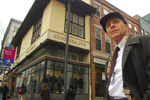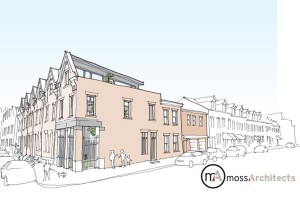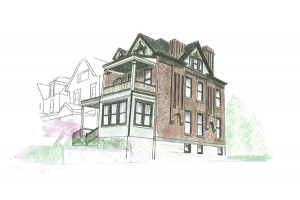
Category Archive: Real Estate Development
-
Carlynton Votes to Consolidate Elementary Schools
Friday, February 18, 2011By Kim LawrenceThe Carlynton school board voted 5-4 Thursday night to close Crafton and Carnegie Elementary Schools and build a new school at the site of the existing Carnegie Elementary School.
The decision came after about two hours of listening to Crafton parents discuss the devastation that would occur if they lost their neighborhood elementary school. Carnegie council members said they would welcome a consolidated school in their neighborhood.
School board President Thomas W. Brown, Vice President Patty Schirripa, Sandra Hughan, Ronald McCartney, and Thomas Di Pietro voted for this consolidation. Board members Nyra Schell, Betsy Tassaro, Sharon Wilson and Raymond Walkowiak dissented. Mr. McCartney made the motion to build a new elementary school at the Carnegie site to accomodate all of the children in the district. Director DiPietro seconded the motion.
The details have yet to emerge regarding where the students will go when their school is torn down. Mr. McCartney said that the Carnegie athletic field would remain intact.
-
Plans Revealed for Ex-Fayette Hospital Site
By Richard Gazarik, TRIBUNE-REVIEW
Wednesday, February 16, 2011An Allegheny County development firm plans to build a medical facility and student housing at the site of the former Brownsville Tri-County Hospital in Fayette County, a company official disclosed.
Falck Properties of Bethel Park said Tuesday that plans include an urgent-care facility, blood lab, senior citizen center, and a restaurant and cafeteria.
Spokeswoman Karen Frank said the housing will be for upperclassmen and graduate students who attend nearby California University of Pennsylvania in Washington County.
The company is not affiliated with the school, university officials said last week.
The Fayette County Planning Commission last week unanimously recommended a zoning change that will allow development of the 27-acre site. A public hearing on the zoning change will be March 24 in Uniontown, a planning commission clerk said.
The hearing occurs two days before a bankruptcy court-imposed deadline to complete the sale to Falck in order to avoid a sheriff’s sale of the property.
A bankruptcy court judge gave Falck until March 26 to complete the transaction. Parkvale Bank, which is owed $1.2 million, wants to sell the property to the highest bidder but agreed to delay the sale to give Falck time to obtain financing.
“We are hoping that the Falck Properties will create a stable tax base for Redstone Township and will lead to additional opportunities for other land and business owners,” Frank said.
Falck is paying $1.8 million for the property and has submitted $180,000 in hand money, which will be forfeited if the sale is not completed, according to a court order.
The sale hit a snag when it was discovered that the property was misadvertised as zoned for commercial use when its actual zoning classification is residential. That error has prevented Falck from obtaining financing for the project.
Brownsville Hospital closed in 2006 because it was losing money. Another group of investors reopened the hospital but could not make the facility profitable.
Since then, community leaders searched for ways and the financial means to restart a hospital but have not been successful.
-
Construction Managers Picked for New Hill Grocery
Thursday, February 10, 2011
By Mark Belko, Pittsburgh Post-GazetteConstruction Managers Picked for New Hill Grocery
A Hill District grocery store is moving a step closer to reality.
The Hill House Economic Development Corp. announced today that it had hired the joint venture team of L.S. Brinker and CM Solutions to serve as construction managers for the project.
The minority-owned firms will oversee the construction of the 36,410-square-foot retail plaza on Centre Avenue that will contain a full-service Shop ‘n Save store. Brinker is headquartered in Detroit with offices in Pittsburgh, and CM Solutions is Pittsburgh-based.
Site work is expected to begin in March. The goal is to open the grocery before Thanksgiving. Besides the supermarket, the plaza will contain 6,900 square feet of commercial retail space.
-
Vacant Motel Coming Down
Blue Spruce a Murrysville landmarkThursday, February 10, 2011By Laurie BaileyMurrysville’s landmark Blue Spruce Motel on Route 22 will be demolished at the end of this month.
“Basically, it’s going to be a flat piece of land,” said Hallie Chatfield, revitalization coordinator at the Westmoreland Redevelopment Authority. The organization is funding the demolition contract awarded to A.W. McNabb LLC of Burgettstown. Ms. Chatfield said the $56,800 grant for the work comes from a federal Community Development Block Grant.
Work that will result in the demise of the motel, pool, pool house and beverage area was originally scheduled to start Monday, but the necessary equipment was unavailable, said Ms. Chatfield. A.W. McNabb is contracted to complete the work within 90 days.
“They will first need to do an internal clean-out before they can demolish it,” said Ms. Chatfield who noted the outside probably wouldn’t be coming down for two more weeks.
In 1956, Camille Naffah purchased the five-acre property for $7,500 and tore down the original structure, the ’40s-era John’s Motel. In its place, he built the Blue Spruce, a single-level motel with clean, simple architecture. In the summer, the large public pool attracted locals from surrounding communities.
Stuart Patz remembered coming out to swim as a high school and college student from his Stanton Heights home in the late 1950s and early 1960s when there were few other public pool options.
“All the kids from the East End were there. It was very pleasant and a nice, social thing. I have such great memories, a real nostalgic feeling toward the facility,” said Mr. Patz, now living in Washington, D.C.
In the mid-’80s, a second level, a restaurant and bar were added to the structure. Mr. Naffah lived in an apartment above the motel’s lobby.
In 1996, the aging motel gained brief local notoriety as a location for the movie, “Kingpin,” with Woody Harrelson.
“They really fixed it up, repainted the outside pink and blue,” said John Cardwell, executive director of the Murrysville Economic and Community Development Corporation.
For several years, the property has been vacant, with the paint in the abandoned pool increasingly chipping.
“The motel closed about four years ago. The pool probably has been closed for 10-plus years,” Mr. Cardwell said.
Mr. Naffah tried unsuccessfully to sell his motel in 2005 before his death in 2007. He left the property to his employee, Emily Moroney, who also died that same year.
Currently, the Blue Spruce is part of the estate of Ms. Moroney, which approved the demolition in hopes of making the property more attractive to developers, Mr. Cardwell said.
Right now, there are no plans for the land, which includes a one-acre “banner parklet” adjacent to the Blue Spruce. It is also for sale with the property and is owned by the development corporation.
“I think there is a vision that is consistent with the streetscape study done in the ’90s,” Mr. Cardwell said.
That vision includes small shops and offices.
-
Real Estate Notes
By Sam Spatter, FOR THE PITTSBURGH TRIBUNE-REVIEW
Sunday, February 6, 2011
• An $215,000 agreement with Pittsburgh History & Landmarks Foundation to provide design and construction management for Downtown buildings has been approved by the Urban Redevelopment Authority. Services may include facade renovations, core and shell and life safety improvements, and elevator renovations or installations. The goal is to stimulate occupancy on upper floors in buildings that often have a tenant only on the first floor. Examples are the ISDA property at Forbes and Wood streets and Kashi jewelers, 253 Fifth Ave. -
Row of Vacant Lawrenceville Houses Being Restored with Historic Exteriors, Custom Interiors
Wednesday, February 02, 2011
Pop City Media
Since they were left vacant in 1995, the row of five historic brick houses on 48th Street, between Hatfield and Butler Streets, in Lawrenceville have fallen into terrible shape. With creative design and green construction, the homes are being restored to look the way they would have when they were built in the 19th century, but with customized modern interiors.
The City of Pittsburgh acquired the buildings, with the help of the Lawrenceville Corporation, in 2007 at very low cost using a tax lien process. After receiving proposals from many eager developers, the Lawrenceville Corporation closed on the sale last week with Botero Development, who’s principal Brian Mendelssohn lives in the neighborhood.
“They’re going to be a high quality product. We’re going to restore the exteriors using real materials, meaning real stone and real slate, and install stone steps and things like that to make them look like when they were built,” says Mendelssohn, who is working with Moss Architects on the project. The interiors will be custom-built for the aesthetic whims of the individual buyers, blending historic elements and original materials with modern features, such as stainless steel appliances, and energy efficient design aspects, like a 2-inch white rubber roof.
The homes, which are currently for sale, include four 1900-square-foot, 3-bedroom units with rear yards. Two come with 2.5-baths and the other two have 2-baths. One 1,250-square-foot unit has 2-bedrooms and 2-baths. The houses will be completed by next October and are priced between $180,000 and $265,000. A sixth building was beyond repair, but its lot will serve as a private courtyard for the $265,000 unit.
“I feel the prices are below market value for what these buildings are,” says Mendelssohn. “It will be good for the neighborhood not to start charging $300,000 for homes in Lawrenceville. You don’t want to gentrify your own neighborhood, you want to keep it what it is.”
Writer: John Farley
Source: Brian MendelssohnImage courtesy of Botero Development
-
$10 Million PHLF Redevelopment Projects Restore Three Homes and Create 27 Apartments in Wilkinsburg
Wednesday, February 02, 2011
Pop City Media
When Pop City last reported on The Pittsburgh History and Landmarks Foundation‘s Wilkinsburg redevelopment projects in 2008, four homes in the Hamnett Place neighborhood had successfully been restored. The PHLF recently announced that three more historic Hamnett Place houses, as well as the two-building, 27-unit Crescent Apartment development, are scheduled for completion by fall of 2011.
“It really is one big project because all of these things are kind of interlinked. We also launched a housing resource center in the same area last year and we’ve done a lot of cleaning and vacant lot work around the area. There are a lot of initiatives happening right now in Wilkinsburg that total over $10 million,” says Michael Sriprasert, director of real estate for the PHLF.
“Right now the three properties at 833 and 845 Holland Avenue and 517 Jeanette Street have undergone interior demolition and we have begun construction,” says David Farkas, director of main street programs for the PHLF, in regard to the second phase of the Hamnett Place project that began in December. The PHLF received assistance from Allegheny County Economic Development and The Allegheny Foundation for the restoration of these homes, which will have buyer incomes restricted to 120% of the area median income.
The PHLF is 30% finished with the redevelopment of two buildings in the $8.6 million, 27-unit affordable Crescent Apartments, which was funded by The Pennsylvania Housing Finance Agency, Allegheny County’s Office of Behavioral Health, and private sources.
The PHLF worked with architects Landmarks Design Associates on both the Hamnett Place and Crescent Apartments projects, and with Mistick Construction and Sota Construction on the Hamnett Place and Crescent Apartments, respectively.
Writer: John Farley
Sources: Michael Sriprasert and David Farkas, PHLFImage courtesy of PHLF
-
Landmarks Foundation Waits for Word on $4 Million State Grant
By Craig Smith
PITTSBURGH TRIBUNE-REVIEW
Wednesday, February 2, 2011
Arthur Ziegler, president of the Pittsburgh History & Landmarks Foundation, surveys Fifth Avenue, Downtown, part of an area his group has earmarked for more redevelopment like its Market at Fifth project. The foundation is awaiting word on whether a $4 million state grant from former Gov. Ed Rendell's administration will come through. Gov. Tom Corbett is reviewing that grant and others like it. Keith Hodan | Tribune-Review
Arthur Ziegler Jr. likes what he sees Downtown.
Seven apartments and two retailers occupy three historic buildings that were brought back to life through a $3 million Pittsburgh History & Landmarks Foundation project dubbed Market at Fifth. More projects in the area could come to fruition if a $4 million state grant comes through.
“I am very pleased … the momentum is gaining,” said Ziegler, the foundation’s president.
Ziegler hopes to leverage the $4 million grant from former Gov. Ed Rendell to do more historic renovation work. Gov. Tom Corbett, who took office last month, is reviewing the grants, handed out in the final days of the Rendell administration through the state’s Redevelopment Assistance Capital Program, or RCAP.
The money was committed to Pittsburgh for historic building facade and core shell restoration, Ziegler said. The city appointed the landmarks foundation to carry out the work.
“It would be a great project for the city and Downtown,” said Rob Stephany, executive director of the city Urban Redevelopment Authority.
Some leaders criticized Rendell’s use of the RCAP grants, which come from borrowed money. Corbett said before he took office he would review all of the grants Rendell approved at the end of his term.
“We’re trying to go through the RCAPs as quickly as possible to make a decision,” said Kevin Harley, spokesman for Corbett.
Other areas of the country are successfully using historic renovation to spur development.
“We’re seeing a real move back to our center city — businesses and residents,” said Kevin Schwab, vice president of communications for CenterState Corp. for Economic Opportunity in Syracuse, N.Y.
Since the late 1980s, the downtown population has doubled from 1,000 to 2,000 people and 16 of 18 condos near a historic district have been sold, Schwab said. In the past decade, the revitalization has gained momentum, even during the recession, he added.
“It has all been driven by the rehabilitation of buildings that have been deemed historic,” he said.
New buildings are going up “with an eye toward being in concert” with what is already around them, he said.
If the $4 million grant for Pittsburgh survives Corbett’s review, the landmarks foundation plans to augment it with donated funds “so we can really solidify the new quality retailing we introduced with Market at Fifth,” Ziegler said.
“We would like to double (the $4 million),” he said.
The money would be used to renovate a half-dozen historic buildings scattered in the Fifth and Forbes area that have been scheduled for preservation since the days of former Mayor Tom Murphy, Ziegler said.
The Market at Fifth project restored three buildings within the Market Square historic district, including the former Regal Shoe Co., which opened in 1908.
The Regal building was designed by Alden & Harlow, then one of the city’s prominent architectural firms, responsible for the Carnegie Institute and Library additions in Oakland, and Carnegie branch libraries in various communities.
Its chief designer was one of the firm’s principals, Frank E. Alden, who in the late 1800s worked with architect H.H. Richardson supervising construction of noteworthy Downtown buildings such as the Allegheny County Courthouse and the Allegheny County Jail.


